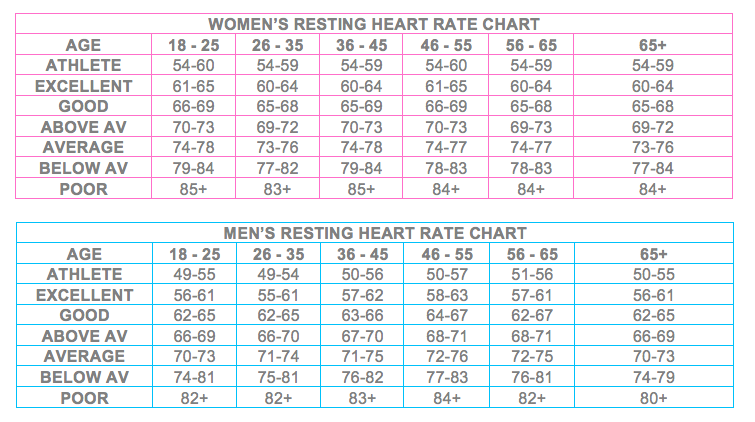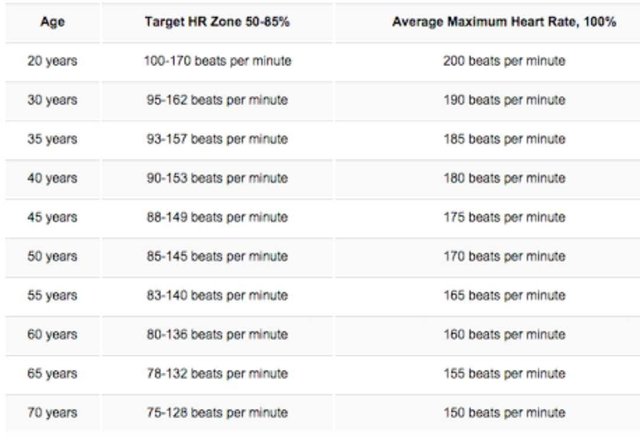Your Olympic athletes have lower resting heart rates because images are ready in this website. Olympic athletes have lower resting heart rates because are a topic that is being searched for and liked by netizens today. You can Get the Olympic athletes have lower resting heart rates because files here. Download all free vectors.
If you’re searching for olympic athletes have lower resting heart rates because images information connected with to the olympic athletes have lower resting heart rates because topic, you have come to the ideal blog. Our website always gives you suggestions for viewing the highest quality video and picture content, please kindly search and locate more informative video articles and graphics that match your interests.
Olympic Athletes Have Lower Resting Heart Rates Because. Increasing blood flow triggers a faster heartbeat. Olympic athletes have lower resting heart rates because A. Athletic heart syndrome is a non-pathological condition commonly seen in sports medicine in which the human heart is enlarged and the resting heart rate is lower than normal. So the reason why athletes have a lower RHR is that in one single contraction of the heart more blood is pumped out as against other peoples heart.
 40 Beats Per Minute Resting Heart Rate Joshua Spodek From joshuaspodek.com
40 Beats Per Minute Resting Heart Rate Joshua Spodek From joshuaspodek.com
Professional athletes on the other hand can develop extraordinary cardiovascular efficiency. Because the heart muscle of conditioned athletes enlarges and strengthens the hearts of athletes pump more blood per beat. Athletes can develop very low heart rates at rest. Olympic athletes have lower resting heart rates because was asked on May 31 2017. View the answer now. People who are moderately active will likely have a resting heart rate similar to the rest of the population – 60 to 100 beats per minute.
View the answer now.
Athletes tend to have lower resting heart rates because training programs that build speed fitness muscle and endurance also train your heart muscles to pump a higher volume of blood with each heartbeat. A well-trained endurance athlete has a resting heart rate of 40 bpm. Your resting heart rate is best measured when youre sitting or lying down. Athletes heart is common in athletes who routinely exercise more than an hour a day and occurs primarily in endurance. It is observed that the normal resting pulse rate for adults is in the range of 60-100 beats per minute. Athletic heart syndrome is a non-pathological condition commonly seen in sports medicine in which the human heart is enlarged and the resting heart rate is lower than normal.
 Source: pinterest.com
Source: pinterest.com
This slowing occurs because training enhances the effects of the involuntary nervous system. They tend to eat low-fat diets. They have a lot of muscle mass due to weightliftingB. They exercise regularly which improves the efficiency of their heart. Olympic athletes have lower resting heart rates because.
 Source: theofy.world
Source: theofy.world
A very fit person may have a resting heart rate as low as 40 beats per minute. People who are moderately active will likely have a resting heart rate similar to the rest of the population – 60 to 100 beats per minute. Heart rhythms for which the elderly require pacemakers are normal in the trained athlete. Increasing blood flow triggers a faster heartbeat. Highly conditioned individuals or high-level athletes often have resting heart rates in the 40s and some may have heart rates less than 30 BPM but otherwise function normally Dr Barber says.
 Source: pinterest.com
Source: pinterest.com
A very fit person may have a resting heart rate as low as 40 beats per minute. Because the heart muscle of conditioned athletes enlarges and strengthens the hearts of athletes pump more blood per beat. View the answer now. Athletes heart is common in athletes who routinely exercise more than an hour a day and occurs primarily in endurance. Miguel Indurain a five-time Tour de France winner and Olympic gold medalist in 1996 recorded a resting heart rate of 28 bpm.
 Source: sbnation.com
Source: sbnation.com
Medical people call this bradycardia. This has a double positive effect there is more blood and oxygen reaching the muscles with less amount of energy expended and the energy that is required is obtained by the saved up carbohydrates in the body rather than proteins. But in the case of athletes this range is lower and comes down to 40-60 beats per minute. They tend to eat low-fat diets. Olympic athletes have lower resting heart rates because A.
 Source: coreprinciples.com.au
Source: coreprinciples.com.au
They exercise regularly which improves the efficiency of their heart. Professional athletes on the other hand can develop extraordinary cardiovascular efficiency. The aerobic training makes all the difference. View the answer now. This slowing occurs because training enhances the effects of the involuntary nervous system.
Source: quora.com
Heart can respond to training like all other muscles in the human body. They exercise regularly which improves the efficiency of their heart. Their lungs tend to be naturally larger. If we are talking about Olympic caliber athletes most of them fall in the range of resting heart rates between 28 40 beats per minute. Athletic heart syndrome is a non-pathological condition commonly seen in sports medicine in which the human heart is enlarged and the resting heart rate is lower than normal.
 Source: joshuaspodek.com
Source: joshuaspodek.com
This has a double positive effect there is more blood and oxygen reaching the muscles with less amount of energy expended and the energy that is required is obtained by the saved up carbohydrates in the body rather than proteins. Olympic athletes have lower resting heart rates because A. Olympic athletes have lower resting heart rates because A. Medical people call this bradycardia. Their lungs tend to be naturally larger.
 Source: pinterest.com
Source: pinterest.com
This slowing occurs because training enhances the effects of the involuntary nervous system. It is observed that the normal resting pulse rate for adults is in the range of 60-100 beats per minute. Your resting heart rate is best measured when youre sitting or lying down. Professional athletes on the other hand can develop extraordinary cardiovascular efficiency. But in the case of athletes this range is lower and comes down to 40-60 beats per minute.
Source: quora.com
A very fit person may have a resting heart rate as low as 40 beats per minute. People who are moderately active will likely have a resting heart rate similar to the rest of the population – 60 to 100 beats per minute. Athletes develop incredibly active parasympathetic vagal tone which results in slow resting rates. Olympic athletes have lower resting heart rates because A. Increasing blood flow triggers a faster heartbeat.
 Source: steemit.com
Source: steemit.com
Because the heart muscle of conditioned athletes enlarges and strengthens the hearts of athletes pump more blood per beat. If we are talking about Olympic caliber athletes most of them fall in the range of resting heart rates between 28 40 beats per minute. Increasing blood flow triggers a faster heartbeat. Olympic athletes have lower resting heart rates because was asked on May 31 2017. An athletes maximum heart rate as well as resting heart rate falls below the pace of the average heartbeat.
 Source: allthestuff.com
Source: allthestuff.com
Athletes heart is common in athletes who routinely exercise more than an hour a day and occurs primarily in endurance. Endurance athletes often have a lower resting heart rate than others. Athletic heart syndrome is a non-pathological condition commonly seen in sports medicine in which the human heart is enlarged and the resting heart rate is lower than normal. Your resting heart rate is best measured when youre sitting or lying down. Heart rate is measured in beats per minute bpm.
 Source: id.pinterest.com
Source: id.pinterest.com
View the answer now. They have a lot of muscle mass due to weightliftingB. Your resting heart rate is best measured when youre sitting or lying down. It is observed that the normal resting pulse rate for adults is in the range of 60-100 beats per minute. Heart can respond to training like all other muscles in the human body.
 Source: pinterest.com
Source: pinterest.com
Fittest of the Fit. Miguel Indurain a five-time Tour de France winner and Olympic gold medalist in 1996 recorded a resting heart rate of 28 bpm. A very fit person may have a resting heart rate as low as 40 beats per minute. It is observed that the normal resting pulse rate for adults is in the range of 60-100 beats per minute. View the answer now.
 Source: rappler.com
Source: rappler.com
Was asked on May 31 2017. Fittest of the Fit. Athletic heart syndrome is a non-pathological condition commonly seen in sports medicine in which the human heart is enlarged and the resting heart rate is lower than normal. Highly conditioned individuals or high-level athletes often have resting heart rates in the 40s and some may have heart rates less than 30 BPM but otherwise function normally Dr Barber says. But in the case of athletes this range is lower and comes down to 40-60 beats per minute.
 Source: blog.mapmyrun.com
Source: blog.mapmyrun.com
This has a double positive effect there is more blood and oxygen reaching the muscles with less amount of energy expended and the energy that is required is obtained by the saved up carbohydrates in the body rather than proteins. They tend to eat low-fat diets. But in the case of athletes this range is lower and comes down to 40-60 beats per minute. Olympic athletes have lower resting heart rates because A. This slowing occurs because training enhances the effects of the involuntary nervous system.
 Source: joshuaspodek.com
Source: joshuaspodek.com
Athletic heart syndrome is a non-pathological condition commonly seen in sports medicine in which the human heart is enlarged and the resting heart rate is lower than normal. Their lungs tend to be naturally larger. Olympic athletes have lower resting heart rates because A. If we are talking about Olympic caliber athletes most of them fall in the range of resting heart rates between 28 40 beats per minute. They exercise regularly which improves the efficiency of their heart.
 Source: pinterest.com
Source: pinterest.com
Olympic athletes have lower resting heart rates because was asked on May 31 2017. View the answer now. Your resting heart rate is best measured when youre sitting or lying down. They exercise regularly which improves the efficiency of their heart. Compare this to the average person and heart rates.
 Source: reddit.com
Source: reddit.com
Their lungs tend to be naturally larger. Fittest of the Fit. Miguel Indurain a five-time Tour de France winner and Olympic gold medalist in 1996 recorded a resting heart rate of 28 bpm. This slowing occurs because training enhances the effects of the involuntary nervous system. Olympic athletes have lower resting heart rates because.
This site is an open community for users to submit their favorite wallpapers on the internet, all images or pictures in this website are for personal wallpaper use only, it is stricly prohibited to use this wallpaper for commercial purposes, if you are the author and find this image is shared without your permission, please kindly raise a DMCA report to Us.
If you find this site adventageous, please support us by sharing this posts to your preference social media accounts like Facebook, Instagram and so on or you can also bookmark this blog page with the title olympic athletes have lower resting heart rates because by using Ctrl + D for devices a laptop with a Windows operating system or Command + D for laptops with an Apple operating system. If you use a smartphone, you can also use the drawer menu of the browser you are using. Whether it’s a Windows, Mac, iOS or Android operating system, you will still be able to bookmark this website.






